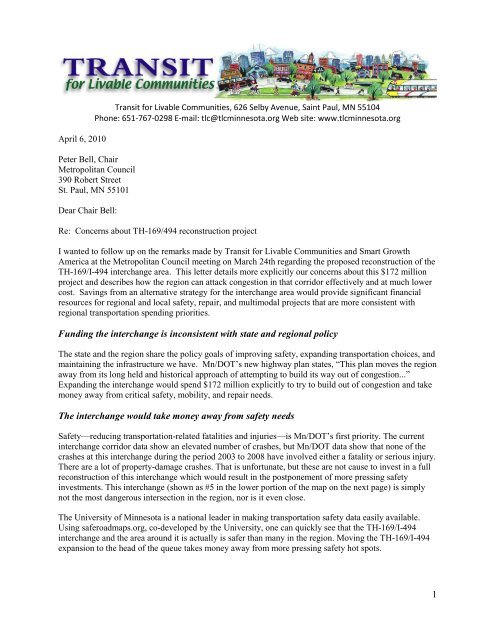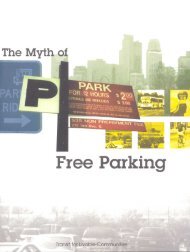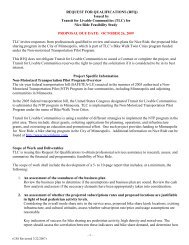Letter to the Metropolitan Council Chairman Peter Bell regarding ...
Letter to the Metropolitan Council Chairman Peter Bell regarding ...
Letter to the Metropolitan Council Chairman Peter Bell regarding ...
Create successful ePaper yourself
Turn your PDF publications into a flip-book with our unique Google optimized e-Paper software.
April 6, 2010<br />
Transit for Livable Communities, 626 Selby Avenue, Saint Paul, MN 55104<br />
Phone: 651-767-0298 E-mail: tlc@tlcminnesota.org Web site: www.tlcminnesota.org<br />
<strong>Peter</strong> <strong>Bell</strong>, Chair<br />
<strong>Metropolitan</strong> <strong>Council</strong><br />
390 Robert Street<br />
St. Paul, MN 55101<br />
Dear Chair <strong>Bell</strong>:<br />
Re: Concerns about TH-169/494 reconstruction project<br />
I wanted <strong>to</strong> follow up on <strong>the</strong> remarks made by Transit for Livable Communities and Smart Growth<br />
America at <strong>the</strong> <strong>Metropolitan</strong> <strong>Council</strong> meeting on March 24th <strong>regarding</strong> <strong>the</strong> proposed reconstruction of <strong>the</strong><br />
TH-169/I-494 interchange area. This letter details more explicitly our concerns about this $172 million<br />
project and describes how <strong>the</strong> region can attack congestion in that corridor effectively and at much lower<br />
cost. Savings from an alternative strategy for <strong>the</strong> interchange area would provide significant financial<br />
resources for regional and local safety, repair, and multimodal projects that are more consistent with<br />
regional transportation spending priorities.<br />
Funding <strong>the</strong> interchange is inconsistent with state and regional policy<br />
The state and <strong>the</strong> region share <strong>the</strong> policy goals of improving safety, expanding transportation choices, and<br />
maintaining <strong>the</strong> infrastructure we have. Mn/DOT’s new highway plan states, ―This plan moves <strong>the</strong> region<br />
away from its long held and his<strong>to</strong>rical approach of attempting <strong>to</strong> build its way out of congestion...‖<br />
Expanding <strong>the</strong> interchange would spend $172 million explicitly <strong>to</strong> try <strong>to</strong> build out of congestion and take<br />
money away from critical safety, mobility, and repair needs.<br />
The interchange would take money away from safety needs<br />
Safety—reducing transportation-related fatalities and injuries—is Mn/DOT’s first priority. The current<br />
interchange corridor data show an elevated number of crashes, but Mn/DOT data show that none of <strong>the</strong><br />
crashes at this interchange during <strong>the</strong> period 2003 <strong>to</strong> 2008 have involved ei<strong>the</strong>r a fatality or serious injury.<br />
There are a lot of property-damage crashes. That is unfortunate, but <strong>the</strong>se are not cause <strong>to</strong> invest in a full<br />
reconstruction of this interchange which would result in <strong>the</strong> postponement of more pressing safety<br />
investments. This interchange (shown as #5 in <strong>the</strong> lower portion of <strong>the</strong> map on <strong>the</strong> next page) is simply<br />
not <strong>the</strong> most dangerous intersection in <strong>the</strong> region, nor is it even close.<br />
The University of Minnesota is a national leader in making transportation safety data easily available.<br />
Using saferoadmaps.org, co-developed by <strong>the</strong> University, one can quickly see that <strong>the</strong> TH-169/I-494<br />
interchange and <strong>the</strong> area around it is actually is safer than many in <strong>the</strong> region. Moving <strong>the</strong> TH-169/I-494<br />
expansion <strong>to</strong> <strong>the</strong> head of <strong>the</strong> queue takes money away from more pressing safety hot spots.<br />
1
Fatalities, west side of <strong>the</strong> region, 2003-2007 (latest full data available)<br />
Mn/DOT and <strong>the</strong> Department of Public Safety have made enormous strides in improving <strong>the</strong> safety of <strong>the</strong><br />
regional transportation system, but much remains <strong>to</strong> be done. Moving a relatively safe intersection <strong>to</strong> <strong>the</strong><br />
<strong>to</strong>p of <strong>the</strong> funding queue takes money away from places with greater safety needs, and belies <strong>the</strong><br />
commitment that Mn/DOT and <strong>the</strong> <strong>Metropolitan</strong> <strong>Council</strong> have made <strong>to</strong> make safety <strong>the</strong>ir first priority.<br />
Continued on next page<br />
2
The interchange would take money away from higher priority projects<br />
Mobility—including easing congestion—is Mn/DOT’s second priority. Mn/DOT data show that this<br />
intersection is not <strong>the</strong> most congested in <strong>the</strong> region. As reported in Mn/DOT’s Feb 2010 Congestion<br />
Report, this interchange experiences serious congestion in one direction during <strong>the</strong> morning peak period<br />
and minimal congestion in <strong>the</strong> evening. Many o<strong>the</strong>r locations throughout <strong>the</strong> region experience<br />
congestion much broader in time and scope.<br />
AM peak congestion - 2009 PM peak congestion -2009<br />
Nor will investment here produce meaningful or long-term improvement. Investing $172 million in<strong>to</strong> one<br />
small section of Hwy. 169 <strong>to</strong> attack congestion in one direction during one peak will move <strong>the</strong> morning<br />
traffic jam a couple of miles. Vehicles coming northbound would simply arrive more quickly at <strong>the</strong><br />
congestion on eastbound I-494. The region needs a plan <strong>to</strong> provide alternatives <strong>to</strong> congested travel.<br />
The interchange would take money away from needed repair projects<br />
A third Mn/DOT priority is <strong>to</strong> bring our roads and bridges in<strong>to</strong> a state of good repair. Spending<br />
$172 million <strong>to</strong> fully reconstruct intersections and an interchange that are not in poor condition while<br />
<strong>the</strong>re are many metro area road and bridge segments in poor condition is inconsistent with that priority.<br />
Mn/DOT’s new Statewide Transportation Plan acknowledges that Mn/DOT does not currently meet and<br />
will not be able <strong>to</strong> meet its targets for pavement quality, resulting in a doubling of <strong>the</strong> percentage of<br />
arterial roads in poor condition by 2012 (see p. 7.2-5). Delayed maintenance of roads and bridges results<br />
in higher overall costs for repair and replacement, while well-maintained roads improve fuel efficiency,<br />
reduce vehicle depreciation, and increase driver safety.<br />
Moving this project <strong>to</strong> <strong>the</strong> <strong>to</strong>p of <strong>the</strong> funding queue takes money away from communities with repair<br />
needs, and belies <strong>the</strong> commitment that Mn/DOT and <strong>the</strong> <strong>Metropolitan</strong> <strong>Council</strong> have made <strong>to</strong> a state of<br />
good repair.<br />
We can spend less money and get a better result<br />
Fortunately, it is possible <strong>to</strong> attack both <strong>the</strong> current crash rate and <strong>the</strong> rush hour congestion with<br />
approaches that are both cheaper and proven by Mn/DOT.<br />
3
1. Reduce crashes by redesigning <strong>the</strong> current approaches<br />
Mn/DOT can slow <strong>the</strong> traffic heading in<strong>to</strong> <strong>the</strong> congested part of existing Hwy. 169 by installing<br />
variable speed limits and warning flashers similar <strong>to</strong> what exists on TH61 northbound, just south of I-<br />
94. These measures slow traffic when necessary and allow higher speeds when not necessary. This<br />
approach can be installed more or less immediately compared <strong>to</strong> <strong>the</strong> current time frame proposed for<br />
<strong>the</strong> expansion.<br />
2. Reduce congestion by offering commuters choices<br />
The congestion in this corridor is entirely from commuters. Mn/DOT and <strong>the</strong> affected jurisdictions<br />
can take numerous actions <strong>to</strong> give commuters in that corridor ways <strong>to</strong> avoid <strong>the</strong> morning congestion.<br />
• Mn/DOT could work more closely with employers in <strong>the</strong> corridor. A 2007 Mn/DOT study found<br />
that investing in Transportation Management Associations was a far more cost-effective way <strong>to</strong><br />
reduce congestion than building new lanes. Mn/DOT’s e-Work program is a national leader; it<br />
can be much more aggressively implemented in that corridor.<br />
• Public transportation options in that corridor are minimal (less than 20 northbound buses each<br />
morning); <strong>the</strong>se can be substantially increased. Mn/DOT and local communities all along <strong>the</strong> I-<br />
494 corridor have been making roadway improvements <strong>to</strong> allow for an arterial BRT system<br />
parallel <strong>to</strong> I-494. Now all that is needed is <strong>the</strong> transit.<br />
All of <strong>the</strong>se cost less and can be put in place more quickly than a multi-level interchange. And all of<br />
<strong>the</strong>se options would reduce congestion throughout <strong>the</strong> corridor, not just at a single interchange.<br />
We need <strong>to</strong> put our time and money in<strong>to</strong> a better system, not more of <strong>the</strong> same<br />
As <strong>the</strong> region grows, we’re going <strong>to</strong> need some new roads, but a giant interchange is not going <strong>to</strong> move us<br />
<strong>to</strong>wards <strong>the</strong> system we need. This interchange expansion would take money and Mn/DOT attention away<br />
from projects that take care of what we have, improve safety, and improve choices. With <strong>the</strong> savings that<br />
could come from a lower-cost solution, <strong>the</strong>re could be as much as $150 million available for o<strong>the</strong>r<br />
transportation needs in <strong>the</strong> region such as:<br />
• Safety. Project savings would pay for hundreds of miles of cable median barrier, shown <strong>to</strong><br />
dramatically reduce fatalities and <strong>the</strong> most serious injuries. These funds could buy intersection<br />
lighting and rumble strips for more rural parts of <strong>the</strong> region –low cost investments that also are<br />
proven <strong>to</strong> reduce fatalities.<br />
• Choice and mobility. Federal funding being used for <strong>the</strong> project would pay for <strong>the</strong> $43 million in<br />
metro-area transit capital projects in <strong>the</strong> bonding bill that were ve<strong>to</strong>ed by <strong>the</strong> Governor. These<br />
investments would ensure that we accelerate <strong>the</strong>se vital transit corridors and maximize federal<br />
funding.<br />
• Repair. State highway and local pavements are currently in <strong>the</strong> worst condition in state his<strong>to</strong>ry<br />
and are projected <strong>to</strong> get much worse. A far greater percentage of mo<strong>to</strong>rists are affected by<br />
potholes and poor road condition than are affected by <strong>the</strong> interchange at TH-169/I-494. $150<br />
million would buy dozens of miles of mill and overlay and new pavement across <strong>the</strong> metro<br />
region.<br />
• Compliance with ADA. Minnesota should meet its obligations <strong>to</strong> make state and local roads more<br />
accessible for people with disabilities.<br />
4
Every poll shows that citizens want <strong>the</strong>ir transportation system <strong>to</strong> provide safety, mobility, and good<br />
repair. Polls also show that <strong>the</strong> nearly 75% of individuals without convenient access <strong>to</strong> transit would like<br />
more transportation choices. A majority of voters also say that government must be held accountable for<br />
how our transportation tax dollars are spent.<br />
Driving and congestion patterns have changed, technology has changed, and <strong>the</strong> region has learned a lot<br />
about what works. The <strong>Council</strong> and <strong>the</strong> state have become national leaders in using more innovative<br />
approaches <strong>to</strong> address congestion and put in place flexible, multi-modal corridors.<br />
Transit for Livable Communities urges you not <strong>to</strong> add this project <strong>to</strong> <strong>the</strong> Transportation Improvement<br />
Program as currently scoped. We would like <strong>to</strong> work with you, and could offer resources, <strong>to</strong> develop and<br />
quickly implement an alternative plan for this corridor that addresses <strong>the</strong> local concerns, while adding <strong>to</strong><br />
<strong>the</strong> safety, mobility, and good repair of <strong>the</strong> regional transportation system.<br />
Sincerely,<br />
Barb Thoman, Acting Executive Direc<strong>to</strong>r<br />
Transit for Livable Communities<br />
Cc:<br />
Tom Sorel, Commissioner, MnDOT<br />
Donn Wiski, Chair, TAB<br />
Kevin Roggenbuck, Administra<strong>to</strong>r, TAB<br />
Tim Mayasich, Chair, TAC<br />
5








